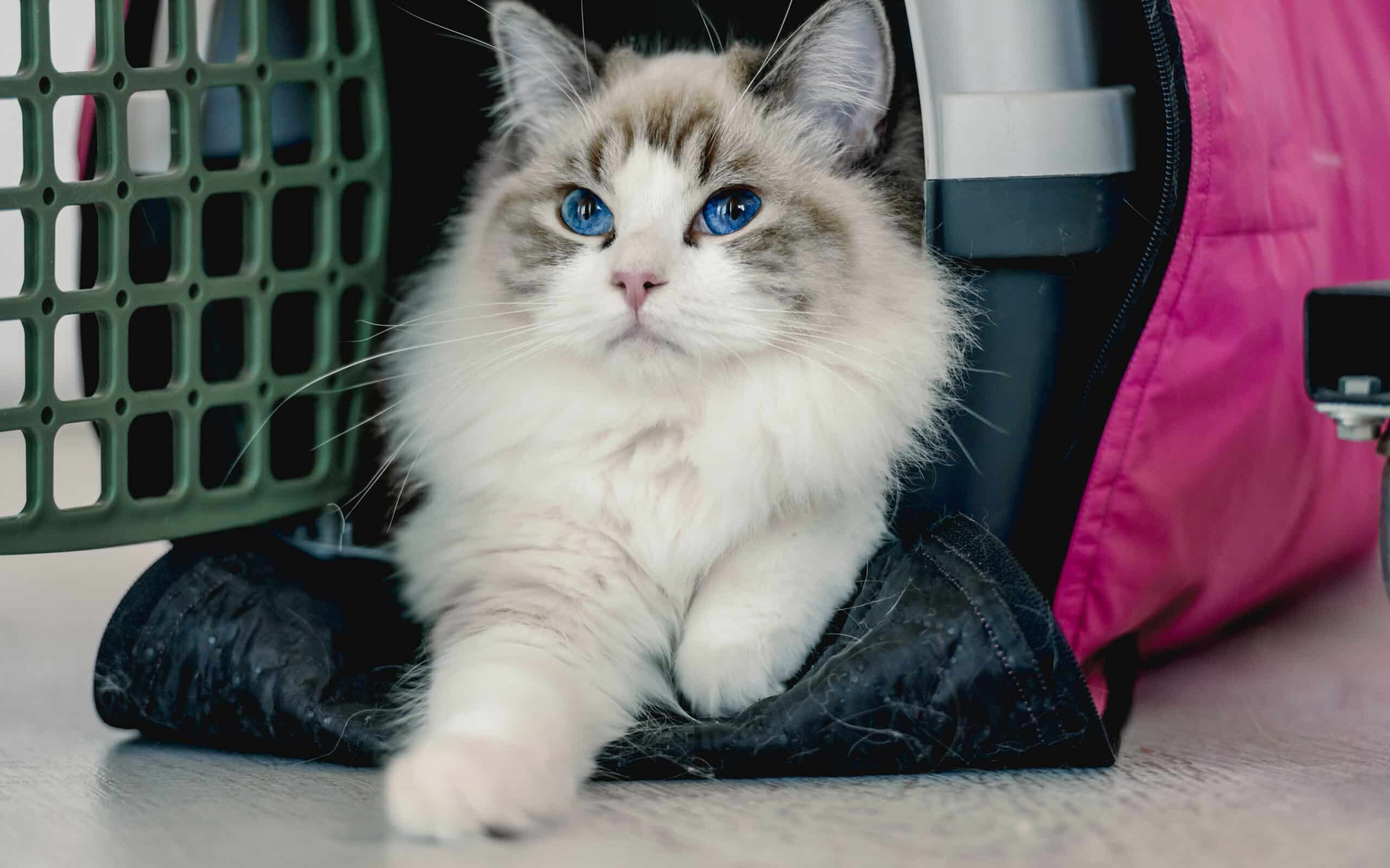
How to find a lost cat
The video in this article explains how to find a lost cat. It’s designed to help anyone who has a missing cat and needs to know how to find it. You’ll find a full transcript of the video below.
Quick Links:
Why do cats go missing?
Your cat is born to hunt. Its natural prey is most active in the morning and evening. This is why cats are active, alert, playful, and prone to roaming at the beginning and end of your day. While out and about, a cat is drawn to places where it’s most likely to find prey.
Cats are inquisitive creatures. They’re attracted to exploring new sights, sounds, and smells. And will happily return home covered in cobwebs, dirt, and sticky seeds!
All this activity adds to the interest and excitement experienced by a cat and contributes to its well-being. But it’s also at the heart of why cats go missing.
How do cats go missing?
There are many reasons why cats go missing. Here are a few examples…
- When exploring a garage or garden shed, a cat may find itself trapped inside
- A cat may find its home too stressful and leave on its own accord
- An unwitting neighbor might shut and lock a door without realizing a cat is hiding inside
- If a cat is startled, it may panic and flee from whatever startled it
- When running from danger, a cat could lose its bearings and then be unable to find its way home
- If a cat runs out onto the road, it might be run over
- A rare breed of cat may be targeted by thieves and stolen
- A cat may crawl into the back of a pickup, ute, or van and fall asleep. If the owner doesn’t realize the cat is there, it can end up far from home
How to find a lost cat
If your cat is missing, get together the kit you’ll need to conduct a search…

A flashlight or torch
The light on your phone isn’t powerful enough. And get fresh batteries.

Your smartphone
Use it to make notes and use the maps app to ensure you don’t miss anything.

A favorite treat
Ideally, this is dry food in a packet that has a familiar rattle.

A cat carrier
Bring a cat carrier when searching your wider neighborhood.
If you’ve trained your cat to respond to a clicker, bring that too.
There are three separate zones in which your search takes place…
- Inside your house
- Outside your house but within your property
- Beyond your property
It’s helpful to think about each zone before you start searching. And to make a list of places you’ve searched as you go. That way, you know you’ve covered every possible hiding place.
Use the CatInfo.net missing cat checklist as a guide.
How to find a lost cat inside your house
Start your search inside your house. Examine every room. The key thing to remember is to think like a cat. Look in every cupboard, closet, and appliance. Look under sofas, tables, and behind furniture. Check laundry baskets, under blankets, and piles of clothing.
Check lofts, attics, and basements.
Don’t assume your cat wouldn’t enter, hide, or can’t fit into something. They can fit into the smallest of places. So look everywhere.

If you can’t easily see under or behind something, use your phone’s camera and take a photo. If a cupboard, closet, attic, or cellar is dark, use your torch.
Rattle the treat packet and call your cat.
Search your property
Search outside your house but within your property. Explore your entire property. Include trees and shrubs, outbuildings, sheds, lock boxes, and rooves.
Search external cellars, under decking, under your house, wells, water tanks, and any other structure. If you have a suitable ladder, make sure you search the roof of structures.
Search your car, including its trunk or boot.
Rattle the treat packet and call your cat. Be alert for your cat’s call. He or she may be trapped and call out on hearing your voice.
Leave scent markers at strategic locations
While searching your property’s exterior, leave scent markers in strategic locations. These act as a signal to your cat that it’s home. Potential scent markers include…
- Your cat’s litter tray
- A favorite blanket
- Your cat’s toys
- Worn shoes
- Worn clothing
In other words, scent markers are items that contain either the cat’s scent, your scent, or both.
These should be left in places where your cat enters/exits the property. Think in feline rather than human terms. For example, if you have a fence, leave the scent marker on top rather than below it.
Looking for your cat in the wider neighborhood
Search beyond your property. There are three different times of day to consider when searching beyond your property…
- Early morning
- During hours of good daylight
- Late evening
It’s quieter early in the morning and late in the evening. So you’re more likely to hear your cat call if trapped. And your cat is also more likely to be active.
During hours of good daylight, you’re more likely to see your cat. For example, if the worst has happened you’re more likely to find its body.
Ask your neighbors for permission to search their properties. Look everywhere just as you did on your own property.
Search the streets in your area. Be systematic. Walk up and down every street several times and at different times of the day.
Call out to your cat and rattle the treat packet. But keep in mind, a scared cat will instinctively stay silent and may not answer your call.
Explore abandoned houses, parks, supermarkets, and building sites where access is permitted. Get on your hands and knees to look underneath vehicles.
Cats can go places we can’t. Look up, down, inside, on top, between, and under anything your cat may have visited.
While you’re out, make a list of the streets you’ve visited and note down useful places to hang a “Missing Cat” poster. This includes…
- Community notice boards
- Shop windows
- Lamp posts
- Walls
- Bus and tram stops
- Railway stations
- A wharf or jetty
Where to look for your lost cat
Cats have flexible spines and can fit into very small spaces. They can also climb and reach areas we simply can’t go.
It’s important to remember your cat’s awesome abilities when searching.
Despite their gymnastic talents, cats do get stuck. Just because a cat can enter a space is no guarantee it can exit. And the ability to climb up doesn’t guarantee it can climb down.
When looking for your cat, it’s essential you check everywhere, no matter how unlikely. And that you listen for your cat’s call. Don’t assume your cat isn’t in the clothes drier, a laundry hamper, or a high kitchen cupboard.
Cats have been found in trash cans, washing machines, closets, lock boxes, and even the back of delivery trucks.
Think like your cat. Where does it roam when it leaves your property? What are its favorite hunting spots? How far does it tend to roam? Has it made friends with other cats in your neighborhood?
A high fence is no challenge to most cats. Check every backyard you can gain access to, including those on surrounding streets.

Is your cat ill, on medication, and/or elderly? If so, it may have become confused and is now unable to find its way home.
If you’re in this situation, look further afield in all directions from your home. And be aware, in this situation, your cat may hide deliberately making it harder to find.
How far to search and useful tools
At a minimum, check a one-square-mile radius from your home. That’s 1.6 kilometers.
Use Google Maps to help you work out where to visit. Use Google Earth to look for things in backyards and other areas you can’t see from the street.
Make a list of every street, alleyway, park, playground, local shops, building sites, and other structures you need to search.
If your local shops have restaurants, be sure to check the area around their dumpsters. A good time to look is when the restaurant is disposing of food.
For some cats, one square mile won’t be enough. This is especially true of unneutered males and unneutered females in heat as they will travel further to find a mate.
If you have a legal way to get a live aerial view of your local area, make use of it to look on top of houses, sheds, water tanks, trees, and other potential structures.
Extra help and resources
Create a Missing Cat poster using the CatInfo.net free Poster app. Print enough copies to put up at least one poster at each location.
Laminate the posters to protect them from rain. If you don’t have access to a laminating machine, insert each poster into a see-through plastic file pocket and seal it with tape.
Put up as many posters as you can. And keep a lookout for your cat while you’re doing so.
Put a copy of your “Missing Cat” poster in every mailbox across your entire search area.
Visit CatInfo.net’s Lost Cat Group. This is a free chat group here on CatInfo.net. In the Lost Cat Group you can talk directly to people who know what you’re going through, have been there themselves, and who want to help you find your cat.
CatInfo.net’s Lost Cat Group is open to free members of CatInfo.net. Join us here. As soon as you’re a member go to Groups and click on the Find Your Lost Cat group.
List your missing cat on social media. For example…
- Your local community Facebook groups
- Neighbourly
- Next door
- Local missing-pet websites
- Other community-based social media apps active in your area
Email your missing cat poster to every local cattery, vet, pet charity, and animal control organization in your area. You can get a PDF copy of your “Missing Cat” poster by printing to PDF.
If your cat is microchipped, include the number in your email. Follow up by phone or in person on a regular basis while your cat is missing.
Stay safe
When searching your neighborhood in the early morning or late evening, remember to keep yourself safe. If you can, let someone know you’re going out searching, and where you intend to go. Remember to call or message when you get back.
Finding your lost cat takes time, effort, and dedication. Return to places you’ve already searched. And keep looking every single day for at least 7 days.












